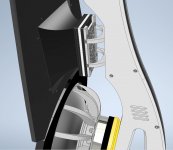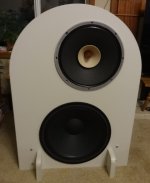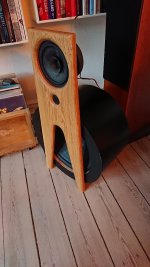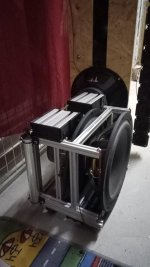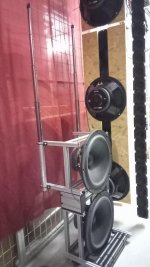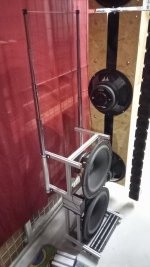Dear LewinskiH01 , I have to thank you for all your messages on diyaudio related to Open Bafle, it was a decisive factor for my to try a TPL 
I remembered earlier about the version with open lid, I am also prepared with a fixation for this case. I'm going to think about that foam waveguide, too.
I don't think I can give up fixing the MDF boards to the speakers, it would be complicated to connect them differently. I'll go as planned and see if it vibrates.
I remembered earlier about the version with open lid, I am also prepared with a fixation for this case. I'm going to think about that foam waveguide, too.
I don't think I can give up fixing the MDF boards to the speakers, it would be complicated to connect them differently. I'll go as planned and see if it vibrates.
Attachments
The first dipole subs I built were 2 H-frames with 4 x 12" DVC woofers back around 2000 when SL first put up his website. The stereo subs from his Phoenix build.
I had Kef coincident monitors at the time, and obtained an active sub crossover with a mic, warble tone generator, level meter and several bands of eq. I crossed the Monitors to the subs at 100hz, measured them and adjusted the response down to 20hz.
I was blown away. A total newbie at the time, I messaged Siegfried to thank him for sharing the plans to build them. I had 3 young children and was working in a research lab at the time, and all this equipment was much more expensive and scarce than it is now. I was fortunate to use some of the lab equipment, as I had to be as frugal as possible.
Siegfried Linkwitz was such a nice person, so sad that he has passed. He told me to make sure that I plugged the ports on the Kefs, which I had not done.
I was hooked on building speakers after that day, and little did I know what a special time in speaker building the next 13 or so years would be, with John Kreskovsky joining in, the crew at the Madisound forum and here... and all the progress that was made with technology and understanding dipoles during that time.
Personally, for me it culminated when we finally had the computer power to run the sims on dipole baffles of different sizes with regards to the size of the driver. They were sent to SL and he posted them on his site. After that we understood that as little baffle as possible was best with regard to avoiding the sharp nulls and diffraction ripple above the dipole peak, where front and back waves come into phase and add together, before rolling off at 6db/oct
It was John K that first put the 4" between the tweeter and the 8", as that was the point where uniformity of polar response broke down and dispersion widened again until the tweeter eventually became directional once more. SL followed suite shortly after and joined the 4 way club, which he had been trying to avoid.
Not only did the 4" help maintain uniform directionality, but JohnK (what a mathematician and software wiz) had realized that with such tiny baffles, the 8" can be crossed right at the dipole peak and only used below it (run "off the baffle" so to speak) avoiding the nulls and ripples, while the peak and dip of the 4" could be dealt with in the crossover, as it was right in the perfect spot if you sized and shaped your baffle and picked your crossover point right.
I still like to experiment with baffle shapes, but aesthetics must play a part also. I try to ensure that the distances from driver to baffle edge are ever changing, but the baffle is small as possible. I try to avoid parallel walls and resonant effects designing the bass section. I like high sensitivity.
And always, like most I'm trying to make the compromises that give my clients the best bang for the buck. The scan 10f 4424 measures almost exactly the same from the front and the rear, has polar response better than some tweeters, and extends past 15khz. I leave the slight rise above 6khz. I cannot hear enough of a difference with a tweeter to justify using one. I remember JohnK saying that he wondered if he needed a tweeter when he first used it.
I enjoy research and experimentation and have built so many different kinds of speakers the last 20 years. I do not enjoy building the same thing twice and avoid it if at all possible.
I am sure your speakers sounded very nice and I appreciate your comments. I look forward to seeing what you build next!
very nice summary of the dipole development over the years, ehh, meanwhile decades
Best, Erik
So interesting to have your contributions here. I'm new to dipoles, just built my 2nd iteration and use 12" sealed subs below 70Hz and one naked (no baffle) 18" per side (it's an active 4-way system). Was wondering how small is the "fairly small baffle" you use with one 15" down to 50-60Hz and how high do you cross to the fullrange? I'm currently xo at 450Hz to an 8" mid. Tried 350Hz but the 8" wasn't liking it. Need to try 400Hz and see if I like it better than 450Hz. I've modelled in The Edge adding a baffle to the 18" to go lower, but seems I would need to cross to the midrange below 300Hz - hence my question.
I still like to use Linkwitz's splmax spreadsheet to do quick estimates of a driver's capability. It can be found under design models at Page index
Enter the Sd of the driver, the x-max (one way, not p-p) and the effective path difference D, which is the center of the driver to the edge of the baffle on one side.
If driver is radiating into half space add 6db. The spreadsheet also gives results for monopole.
Using the Dayton PA380 as a cost effective example, it has 845cm squared of radiating area and an x-max of 5mm. Using a D of 254mm or 10", we find it is capable of 99db at 71hz and 90db at 50hz.
Considering that a frequency of 50hz is 22.5 feet long, it is monaural and will be coming from both speakers, so add 6db for 96db. If you are going to cross to a sealed sub at 50hz, add 6db for 102db.
So, this would be a baffle that could be made only an inch wider than the driver on each side, and a side only an inch and a half, which would add much strength to the baffle. Considering the baffle should be at least an inch thick, you'd only be adding half an inch to the depth...to make it good and strong this is likely as small as you could possibly make it, and you will be avoiding cavity resonance, allowing you to use it higher in frequency.
In his final design Linkwitz crossed the 8" at 120hz to the sub section. His target was based on what an orchestra could hit in a theater, which was ~111db. I use the same target as low as I can, and in the design we just discussed it would be capable of that down to 70hz according to the spreadsheet, and this is a bit on the conservative side...may be a couple more, although you will not benefit from room gain with a dipole.
I crossed to the 8" at just under 200hz in the design I posted above. When doing quick estimates of designs in my head, I just use my 1/3rd rule...when the driver width equals 1/3 of the wavelength it is producing, many different things start to happen as it's dispersion starts to narrow and the cone stops acting like a piston, breaks up into discrete modes and starts to get in your face...baffle step, dipole rolloff...it's all very closely related.
So, using 13,500 inches/second as the speed of sound, divide it by the width of the driver x 3.
13.500/15" x 3 = 300hz
for a 12" 375hz
for a 10" 450hz
for an 8" 562hz
You get the idea. These are just quick approximations but close enough to use a putter.
Of course there are other considerations that would exclude a driver from being used that high, especially with subwoofers. On the flip side if it's clean up there, depending on the crossover you use, it will start rolling off an octave away from the crossover point, so you could use an 8" to around 1200hz and still have pretty uniform directivity through the crossover...and obviously many great speakers stretch it a bit more.
I've made some very cost effective dipoles using 2x10" Peerless sls in an MTM with small full range drivers crossed in the 400-700hz area, depending on capability, that were 3db down at 50hz and reached 15khz on a baffle that was less than a foot wide and around 3" deep.
I don't like to use a fullrange any bigger than 4". Beyond that they're just too directional.
Nice! Here's mine -
How do you like their sound? I put mine asymmetrically, as you can see. The other one is a mirror image.
Attachments
Dear LewinskiH01 , I have to thank you for all your messages on diyaudio related to Open Bafle, it was a decisive factor for my to try a TPL
I remembered earlier about the version with open lid, I am also prepared with a fixation for this case. I'm going to think about that foam waveguide, too.
Thanks for the kind words. I'm a newbie though!
Nice cad ability, BTW!!
Something to keep in mind: the TPL magnet is pretty strong and leavig the back simply open might expose the "membrane" to someone inadvertently moving a steel piece near the magnet...which could lead to destroyed membrane. That would be me working with a screwdriver nearby, or a loose screw...hence I built the back protection to keep myself far away during experimentation. Maybe your are more careful than I am!
When doing quick estimates of designs in my head, I just use my 1/3rd rule...when the driver width equals 1/3 of the wavelength it is producing, many different things start to happen as it's dispersion starts to narrow and the cone stops acting like a piston, breaks up into discrete modes and starts to get in your face...baffle step, dipole rolloff...it's all very closely related.
So, using 13,500 inches/second as the speed of sound, divide it by the width of the driver x 3.
13.500/15" x 3 = 300hz
for a 12" 375hz
for a 10" 450hz
for an 8" 562hz
You get the idea. These are just quick approximations but close enough to use a putter.
Thanks for the input! I have some things to chew on.
Interestingly, the above rule implies 250Hz xo for an 18", like I'm using. And I xo at 450Hz now and tried 350Hz before and I think the 8" midrange (B&C 8PE21) didn't like it that low. I'm running both naked; no baffle. Maybe I need to use a baffle for the 8" to get closer to 300Hz.
LewinskiH01
"Interestingly, the above rule implies 250Hz xo for an 18", like I'm using. And I xo at 450Hz now and tried 350Hz before and I think the 8" midrange (B&C 8PE21) didn't like it that low. I'm running both naked; no baffle. Maybe I need to use a baffle for the 8" to get closer to 300Hz"
Higher resonant frequency and shorter x-max are the trade offs for higher sensitivity, but it helps to retain headroom when you compensate for dipole rolloff. Still, you're 2 octaves above resonant frequency and with 2.5mm x-max, the 8" should be able to do 350hz.
However, in free air I imagine it starts rolling off around 1,000hz or even a bit higher. I assume you're using dsp and implementing a shelving filter to flatten it down to the crossover frequency. The loss of headroom from that may be noticeable and the amp may not like it either.
The 18" is breaking up into modes at that point also. A very steep crossover slope that limits their interaction and keeps the beaming of the 18" above the crossover point out of the equation may help.
I always use some baffle to smooth diffraction ripple in the driver's frequency response. At least the driver you're using has an octagonal shaped frame and helps with this a bit. You never want the baffle to evenly follow the circumference of the driver and the more the distance from driver edge to baffle edge changes the better. I do prefer to keep it symmetrical in the horizontal plane.
Linkwitz went free air with the fullrange mounted over the up firing 6" in the pluto, primarily because of reflections from the woofer and the center to center distancing, and the unfiltered frequency response was some ugly because of it. A circular framed driver in free air, or centered in a circular baffle is the worst case scenario.
The baffle will require less compensation to reach the crossover point and save you headroom. With an 8" driver, you could go another half the radius with the baffle without deleterious effects, adding 2" around the driver...unevenly of course. It may help with the polar response crossing to the 18" also.
You're probably aware of all this, but I don't have a good idea of where you are at yet.
In the end, dipole baffles must be optimized by measurement, but in general don't add more than another half the driver radius (1.5D), keep the transitions and corners soft and rounded and the distance from surround to edge of baffle ever changing as much as possible.
Talking about midrange on up here, not woofer/subwoofer section.
Have fun!
"Interestingly, the above rule implies 250Hz xo for an 18", like I'm using. And I xo at 450Hz now and tried 350Hz before and I think the 8" midrange (B&C 8PE21) didn't like it that low. I'm running both naked; no baffle. Maybe I need to use a baffle for the 8" to get closer to 300Hz"
Higher resonant frequency and shorter x-max are the trade offs for higher sensitivity, but it helps to retain headroom when you compensate for dipole rolloff. Still, you're 2 octaves above resonant frequency and with 2.5mm x-max, the 8" should be able to do 350hz.
However, in free air I imagine it starts rolling off around 1,000hz or even a bit higher. I assume you're using dsp and implementing a shelving filter to flatten it down to the crossover frequency. The loss of headroom from that may be noticeable and the amp may not like it either.
The 18" is breaking up into modes at that point also. A very steep crossover slope that limits their interaction and keeps the beaming of the 18" above the crossover point out of the equation may help.
I always use some baffle to smooth diffraction ripple in the driver's frequency response. At least the driver you're using has an octagonal shaped frame and helps with this a bit. You never want the baffle to evenly follow the circumference of the driver and the more the distance from driver edge to baffle edge changes the better. I do prefer to keep it symmetrical in the horizontal plane.
Linkwitz went free air with the fullrange mounted over the up firing 6" in the pluto, primarily because of reflections from the woofer and the center to center distancing, and the unfiltered frequency response was some ugly because of it. A circular framed driver in free air, or centered in a circular baffle is the worst case scenario.
The baffle will require less compensation to reach the crossover point and save you headroom. With an 8" driver, you could go another half the radius with the baffle without deleterious effects, adding 2" around the driver...unevenly of course. It may help with the polar response crossing to the 18" also.
You're probably aware of all this, but I don't have a good idea of where you are at yet.
In the end, dipole baffles must be optimized by measurement, but in general don't add more than another half the driver radius (1.5D), keep the transitions and corners soft and rounded and the distance from surround to edge of baffle ever changing as much as possible.
Talking about midrange on up here, not woofer/subwoofer section.
Have fun!
Nice! Here's mine -
How do you like their sound? I put mine asymmetrically, as you can see. The other one is a mirror image.
Hey Joe,
I've been reading up on your journey with these. It seems you're where I want to go (similar baffles + bass support).
They sound very promising, but no cigar (yet): I expected a much lower f3 in these baffles (based on the statements on the decware forum). Meanwhile I'm at around 75 hours break-in and building subwoofers to fill in the low end, which should get tonal balance right. They're too bright now, even with a good boost at 100hz...
Do you feel they have sufficient output at 100-200hz in your baffles (btw are the extenders at the back still in place?), and are they smooth enough higher up without RC circuit or other EQ? Curious what to expect after more break-in.
Thanks
Simon
I use around 200 Hz to 7 inch, the 15 inch does not sound very nice above this frequency. Some boost needed but its ok.
Thanks. Yes, its massive oak made out of one piece.
Barrel for woofer is sliced mdf. This is not the best material. Its not heavy enough so I might need some concrete tubes instead.
Thanks. Yes, its massive oak made out of one piece.
Barrel for woofer is sliced mdf. This is not the best material. Its not heavy enough so I might need some concrete tubes instead.
Nice piece of wood, I thought so.
I made concrete tubes once...what a pain.
I've been working a lot with epoxy lately. More expensive build, but you could get very creative with it. Just something to think about. You'll never have to worry about it cracking or rattling, seals super tight obviously, well damped, could be clear, colored, translucent, mixed with wood or whatever you like embedded in it. Casting epoxy takes shapes much better than concrete, and is easier to work with when finishing.
Also lets me use wood that I would have thrown away before, because of cracks or spalted wood that's a bit too rotten and I would not have dared to turn on the lathe. I just embed them in epoxy now, and turn them into a solid shape of whatever thickness I want without fear.
And the wood is not going to shrink, warp or move one bit after it's embedded. Very rugged, beautiful and if someone did happen to accidentally hit it with an axe and take a chip out you could easily fix it too lol
So, using 13,500 inches/second as the speed of sound, divide it by the width of the driver x 3.
13.500/15" x 3 = 300hz
for a 12" 375hz
for a 10" 450hz
for an 8" 562hz[/QUOTE]
This got my attention, and got me thinking about the common quarterwave distances and frequencies to avoid comb filtering on speakers, and help a proper blend between drivers. I applied this to subwoofer placement, and its furthest distance from a satellite. Then I did the same thing with a centred dual driver open baffle bass panel.
I use the open baffle to fill 4 sloped to the 2 slope high passed satellites, and the box sub to pump up the rolled off bass panel, 4 slope filtered at 40 hertz. Whether it was luck or not, the open baffle satellites, bass panel, and sub give apparently seamless bass in my room, with only levels needing tweaking on their plate amps to match. Maybe the open baffle bass stays away from modes and nodes more than an all monopole system would, and the output from the one monopole is pretty benign, so far as exciting room frequency issues is. Anyways, I haven't come across such an easy way of starting bass speaker placement, and frequency settings before, so I thought I'd pass it along. If it's not an accident, I hope it helps.
13.500/15" x 3 = 300hz
for a 12" 375hz
for a 10" 450hz
for an 8" 562hz[/QUOTE]
This got my attention, and got me thinking about the common quarterwave distances and frequencies to avoid comb filtering on speakers, and help a proper blend between drivers. I applied this to subwoofer placement, and its furthest distance from a satellite. Then I did the same thing with a centred dual driver open baffle bass panel.
I use the open baffle to fill 4 sloped to the 2 slope high passed satellites, and the box sub to pump up the rolled off bass panel, 4 slope filtered at 40 hertz. Whether it was luck or not, the open baffle satellites, bass panel, and sub give apparently seamless bass in my room, with only levels needing tweaking on their plate amps to match. Maybe the open baffle bass stays away from modes and nodes more than an all monopole system would, and the output from the one monopole is pretty benign, so far as exciting room frequency issues is. Anyways, I haven't come across such an easy way of starting bass speaker placement, and frequency settings before, so I thought I'd pass it along. If it's not an accident, I hope it helps.
Hello MITsound
Nice set up with a few different things going on.
For the room sizes most people listen in at home, the most problematic range for modes is ~250hz to 50hz. Because dipoles put a third less power to the room and have output that is greatly reduced at 90 degrees off axis, they can really help with this and more so with optimized placement in relation to room geometry.
Below 50hz in the average home listening environment, discrete modes transition to room gain. Sealed subs take the greatest advantage of this, dipoles the least.
The range where the sealed sub and dipole are overlapping is more of a cardioid response, which some have shown may well have the greatest advantage in that area with regard to activating room modes.
Always nice when a post gives food for thought, I'm usually on the receiving end. Such a fascinating hobby, you never know where you will find a piece of the puzzle that illuminates a bigger picture for you.
Sound set up for a sound system pah toom pah
Nice set up with a few different things going on.
For the room sizes most people listen in at home, the most problematic range for modes is ~250hz to 50hz. Because dipoles put a third less power to the room and have output that is greatly reduced at 90 degrees off axis, they can really help with this and more so with optimized placement in relation to room geometry.
Below 50hz in the average home listening environment, discrete modes transition to room gain. Sealed subs take the greatest advantage of this, dipoles the least.
The range where the sealed sub and dipole are overlapping is more of a cardioid response, which some have shown may well have the greatest advantage in that area with regard to activating room modes.
Always nice when a post gives food for thought, I'm usually on the receiving end. Such a fascinating hobby, you never know where you will find a piece of the puzzle that illuminates a bigger picture for you.
Sound set up for a sound system pah toom pah

Ok guys stop it now.... I can't afford another project yet
Let me show my Frankenstein project. I like dipole speakers with naked drivers (or minimal baffle). These are an attempt to make a speaker that can be stored away when not in use. "folded" it measures about 380mm high, 350mm wide and 280mm deep (this can go below a coffee table).
It can unfold with the woofers on top of each other (6dB gain), or keep them in the compound dipole. The woofers are the SB34NRX75-16, which indeed produce a lot of SPL at least enough for me.
On the top frame I attached two telescopic rails (taken from hand luggage trollys, who travels these days anyways...) that extend to max 90cm. Not very strong, but sufficient to hang one's favorite speaker combination for mid high. The telescopic rails can slide in the alu rails, to allow for offset between mid high and woofers.
Currently not in use as I am working on permanent line arrays in the living room, still keeping the frankensteins if I ever want to test some different drivers.
It can unfold with the woofers on top of each other (6dB gain), or keep them in the compound dipole. The woofers are the SB34NRX75-16, which indeed produce a lot of SPL at least enough for me.
On the top frame I attached two telescopic rails (taken from hand luggage trollys, who travels these days anyways...) that extend to max 90cm. Not very strong, but sufficient to hang one's favorite speaker combination for mid high. The telescopic rails can slide in the alu rails, to allow for offset between mid high and woofers.
Currently not in use as I am working on permanent line arrays in the living room, still keeping the frankensteins if I ever want to test some different drivers.
Attachments
Dear LewinskiH01 , I have to thank you for all your messages on diyaudio related to Open Bafle, it was a decisive factor for my to try a TPL
I remembered earlier about the version with open lid, I am also prepared with a fixation for this case. I'm going to think about that foam waveguide, too.
I don't think I can give up fixing the MDF boards to the speakers, it would be complicated to connect them differently. I'll go as planned and see if it vibrates.
Your planned build is super interesting. Could you share some of the thoughts behind your build? For example, why you went with a 3 way and a non-dipole diaphragm tweeter, and what you expect the polar response of the system to look like?
Your choice of some components, the frame and baffle shape remind me of the Kryon Audio Kronos. Did you come to this structure or is it a deliberate hommage?
How will you implement the crossover, amplification, DAC, etc? Will room correction come into play?
Excited to see more renders, photos, and description!
- Home
- Loudspeakers
- Multi-Way
- Ultimate Open Baffle Gallery
